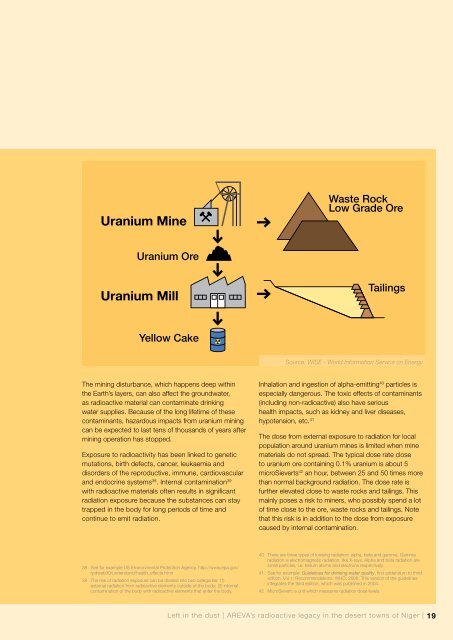Left in the dust - Greenpeace
Left in the dust - Greenpeace
Left in the dust - Greenpeace
Create successful ePaper yourself
Turn your PDF publications into a flip-book with our unique Google optimized e-Paper software.
Uranium M<strong>in</strong>e<br />
Waste Rock<br />
Low Grade Ore<br />
Uranium Ore<br />
Uranium Mill<br />
Tail<strong>in</strong>gs<br />
Yellow Cake<br />
Source: WISE - World Information Service on Energy<br />
The m<strong>in</strong><strong>in</strong>g disturbance, which happens deep with<strong>in</strong><br />
<strong>the</strong> Earth’s layers, can also affect <strong>the</strong> groundwater,<br />
as radioactive material can contam<strong>in</strong>ate dr<strong>in</strong>k<strong>in</strong>g<br />
water supplies. Because of <strong>the</strong> long lifetime of <strong>the</strong>se<br />
contam<strong>in</strong>ants, hazardous impacts from uranium m<strong>in</strong><strong>in</strong>g<br />
can be expected to last tens of thousands of years after<br />
m<strong>in</strong><strong>in</strong>g operation has stopped.<br />
Exposure to radioactivity has been l<strong>in</strong>ked to genetic<br />
mutations, birth defects, cancer, leukaemia and<br />
disorders of <strong>the</strong> reproductive, immune, cardiovascular<br />
and endocr<strong>in</strong>e systems 38 . Internal contam<strong>in</strong>ation 39<br />
with radioactive materials often results <strong>in</strong> significant<br />
radiation exposure because <strong>the</strong> substances can stay<br />
trapped <strong>in</strong> <strong>the</strong> body for long periods of time and<br />
cont<strong>in</strong>ue to emit radiation.<br />
Inhalation and <strong>in</strong>gestion of alpha-emitt<strong>in</strong>g 40 particles is<br />
especially dangerous. The toxic effects of contam<strong>in</strong>ants<br />
(<strong>in</strong>clud<strong>in</strong>g non-radioactive) also have serious<br />
health impacts, such as kidney and liver diseases,<br />
hypotension, etc. 41<br />
The dose from external exposure to radiation for local<br />
population around uranium m<strong>in</strong>es is limited when m<strong>in</strong>e<br />
materials do not spread. The typical dose rate close<br />
to uranium ore conta<strong>in</strong><strong>in</strong>g 0.1% uranium is about 5<br />
microSieverts 42 an hour, between 25 and 50 times more<br />
than normal background radiation. The dose rate is<br />
fur<strong>the</strong>r elevated close to waste rocks and tail<strong>in</strong>gs. This<br />
ma<strong>in</strong>ly poses a risk to m<strong>in</strong>ers, who possibly spend a lot<br />
of time close to <strong>the</strong> ore, waste rocks and tail<strong>in</strong>gs. Note<br />
that this risk is <strong>in</strong> addition to <strong>the</strong> dose from exposure<br />
caused by <strong>in</strong>ternal contam<strong>in</strong>ation.<br />
38 See for example US Environmental Protection Agency. http://www.epa.gov/<br />
rpdweb00/understand/health_effects.html<br />
39 The risk of radiation exposure can be divided <strong>in</strong>to two categories: (1)<br />
external radiation from radioactive elements outside of <strong>the</strong> body; (2) <strong>in</strong>ternal<br />
contam<strong>in</strong>ation of <strong>the</strong> body with radioactive elements that enter <strong>the</strong> body.<br />
40 There are three types of ionis<strong>in</strong>g radiation: alpha, beta and gamma. Gamma<br />
radiation is electromagnetic radiation, like X-rays. Alpha and beta radiation are<br />
small particles, i.e. helium atoms and electrons respectively.<br />
41 See for example: Guidel<strong>in</strong>es for dr<strong>in</strong>k<strong>in</strong>g water quality, first addendum to third<br />
edition. Vol 1: Recommendations. WHO, 2006. This version of <strong>the</strong> guidel<strong>in</strong>es<br />
<strong>in</strong>tegrates <strong>the</strong> third edition, which was published <strong>in</strong> 2004.<br />
42 MicroSievert: a unit which measures radiation dose levels<br />
<strong>Left</strong> <strong>in</strong> <strong>the</strong> <strong>dust</strong> | AREVA’s radioactive legacy <strong>in</strong> <strong>the</strong> desert towns of Niger | 19

















